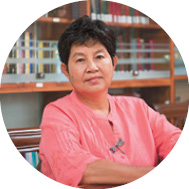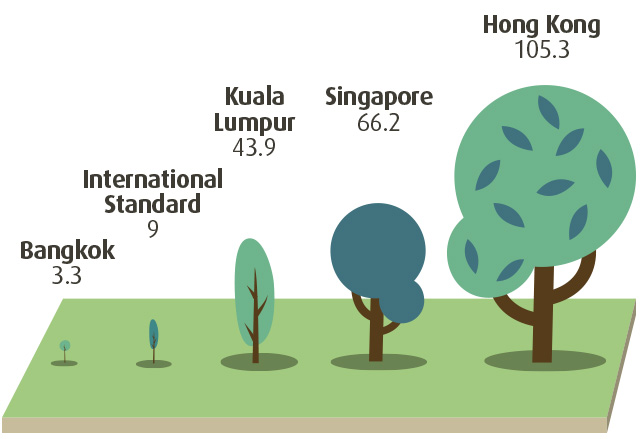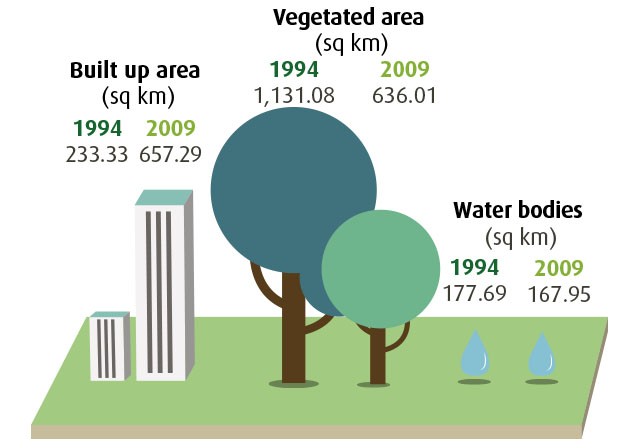This Mar 26, central Bangkok welcomes a rare new park when Chulalongkorn University officially opens CU Centenary Park under the auspices of HRH Princess Maha Chakri Sirindhorn. The 30-rai split-story green space celebrates the university’s 100-year anniversary, and is the centerpiece for a huge redevelopment of the 290-rai Samyan neighborhood, stretching from National Stadium to Rama IV Road, which aims to create Bangkok’s very own mini Silicon Valley—a “smart city” home to innovation and startup businesses.
Ambitious and civil-minded but with plenty of commercial space too, the project is proving a focal point for those who would like to see Bangkok step away from high-rise developments and malls, and towards long-term urban planning. But the total project isn’t all parks and exhibits. While 30 rai (roughly one-tenth Lumphini Park's size) is dedicated to CU Centenary Park, another 40 rai has been allotted to Samyan Mitr Town—a shopping mall, office space and 554-room condominium being developed by Golden Land Property Development Group (the building arm of real estate behemoth TCC Group) at Samyan’s Southern end.
So, pioneering public space or another business-first downtown development? Those invested in the project spell out their hopes and fears.
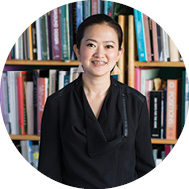
CU Centenary Park’s Potential
Kotchakorn Voraakom, Landprocess, designer of CU Centenary Park
“This area is kind of a showcase for Bangkok. I hope it will lead the direction away from finance and commerce and towards better quality of life and using big plots of land to contribute back to the city. The wastewater we create within the park will be collected, cleaned and used not just in the park, but also to help the neighborhood with water as well. There will be zero water discharge, thanks to a big tank underneath the pavilion at the back of the park that stores run-off water. This project was designed by looking into the future another 100 years: how can green city space help its citizens? How will Bangkok change climactically? When we face drought it’s going to be more extreme; when we approach the rainy season it’s going to rain harder. We propose this area to act like the roof of a raintree, the symbol of Chula, with roots absorbing water unlike concrete roads, and creating a natural system to give back to the city.”

Chula’s Vision
Wisanu Supsombol, vice president for property management and innovation at Chulalongkorn University
“This is a huge plot of land in the heart of the city—an extremely rare find. A lot of people think that property development should be focused on profit-making, but actually our priority is to use this royally-granted land to bring good to society. We looked at what is currently missing from Thailand and came up with the concept of an 'intellectual society,' a space for building a green, innovative and smart city. We hope this can be an example project for the country, to pave the direction that Thailand should be heading towards. In 20 years, Samyan will be the hub for technology and innovation. It will be a great example for Bangkok—and even the world—to follow.”
Heritage Hopes
Sudara Suchaxaya, editor-in-chief at Muang Boran Journal
“Samyan is one of the most historic hubs in Bangkok. It’s where a lot of Chinese immigrants settled when they moved here. It became a huge marketplace and residential area. It’s extremely important to Bangkok. I know we can’t hold onto history forever, but we need to adapt it and bring it along with us somehow. This is especially important in areas like Samyan that once had a lot of character. The development has already begun, a lot of Samyan has already changed and a lot of the character is already lost. But in this case, I think the changes have been acceptable so far. Because Samyan was once a huge marketplace, I believe it’s ok to develop the area into shops and restaurants. I hope that Chula’s plans will stay in line with this. Samyan market is where a lot of university students back in the day went to buy cheap food. They should try to maintain a marketplace vibe for the students, even if it is a modern day market. That way, it can still remain a ‘Samyan Market’ in its own way.”
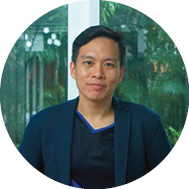
Encouraging Green Development
Yossapon Boonsom, landscape architect at Shma Design
“To change the behavior of most developers you need tax policies and incentives which we haven’t seen from our government. Chula has the authority to develop on its own guidelines. They are a pillar of the country so need to come up with something that’s better than the city standard. For Bangkok development to move forward, the BMA themselves have to come up with an incentive policy, like in Singapore, where developers must earn the right to build more through providing sufficient green space and green walls. That’s never been implemented in Bangkok. Singapore controls everything with government guidelines that developers must adhere to. They have a think tank to make the master plan which developers must follow so their projects benefit people’s lives, the economy and the environment.”
AMOUNT OF GREEN SPACE PER PERSON
LAND USE IN THE BANGKOK METROPOLITAN AREA
BANGKOK’S GREEN FUTURE

MAKKASAN PARK: BACK TO SQUARE ONE
Since 2013, a golden piece of land stretching for 500 rai in the Makkasan area has been a point of public debate. Owned by the State Railway of Thailand, the land was offered to the Finance Ministry’s Treasury Department for a lease of 99 years in trade for recouping the company’s B61 billion debt. However, after news was announced that the ministry aimed to redevelop the land to build Makkasan Complex, a massive commercial zone totaling B200 billion in malls, hotels, hospitals and exhibition space, the public quickly spoke up against the idea, creating discussion projects such as “Friends of Makkasan” which rallied on social media for the land to be used as a public park instead. In 2015, the National Council for Peace and Order suggested for the area to be built as a mixed-space featuring 150 rai of green space, 30 rai for a National Train Museum and a 140-rai commercial zone. In light of the various disagreements and delays, the Finance Minister proposed to withdraw from the debt-for-land agreement in October 2016 and let the SRT take on the development plan for themselves. This was confirmed in December 2016, arguably bringing things back to square one, where it remains to be seen how the SRT will proceed with the land from here on.
Land Use in the Bangkok Metropolitan Area.

Since 1991, the area next to Queen Sirikit Convention Center, totaling 450 rai and owned by the Thailand Tobacco Monopoly, has been slowly transforming into a public park after the company agreed to move its headquarters to Ayutthaya. In 1992, 130 rai of it was turned into the current Benjakitti Park. In August 2016, the space welcomed a 61-rai extension named Suan Pa Benjakitti (Benjakitti Forest Park) which is the beginning of a three-phase plan to further transform the remaining land. Phase 2 will see the addition of another 170 rai of greenery, and Phase 3 another 89 rai. Although the dates of completion are uncertain, some reports are saying by 2020.
Much as the name suggests, the 61-rai space is home to huge clusters of trees organized in blocks to create small forests. Around these blocks, a wide concrete path provides space for runners and bikers. There is also a space dedicated to representative trees from every city in Thailand, with informative signage about their origin and importance. Although a date for the official opening is yet to be confirmed, visitors can now visit the park everyday between 6am-6pm by taking Gate 2 behind the Benjakitti Park carpark.


